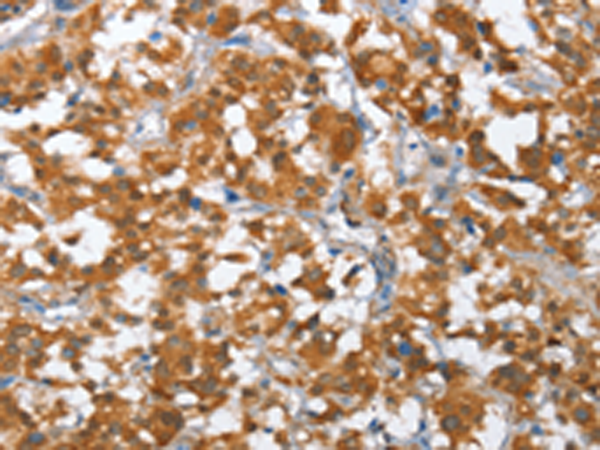


| WB | 咨询技术 | Human,Mouse,Rat |
| IF | 咨询技术 | Human,Mouse,Rat |
| IHC | 1/50-1/200 | Human,Mouse,Rat |
| ICC | 技术咨询 | Human,Mouse,Rat |
| FCM | 咨询技术 | Human,Mouse,Rat |
| Elisa | 1/2000-1/5000 | Human,Mouse,Rat |
| Aliases | BBP; 53BP2; ASPP2; P53BP2; PPP1R13A |
| WB Predicted band size | 126 kDa |
| Host/Isotype | Rabbit IgG |
| Antibody Type | Primary antibody |
| Storage | Store at 4°C short term. Aliquot and store at -20°C long term. Avoid freeze/thaw cycles. |
| Species Reactivity | Human, Mouse |
| Immunogen | Fusion protein of human TP53BP2 |
| Formulation | Purified antibody in PBS with 0.05% sodium azide and 50% glycerol. |
+ +
以下是3篇关于TP53BP2抗体的参考文献,按文献名称、作者和摘要内容概括整理:
1. **文献名称**:*"ASPP2 (TP53BP2) as a prognostic marker and therapeutic target in breast cancer"*
**作者**:Samuels-Lev Y, et al.
**摘要**:该研究利用TP53BP2特异性抗体(ASPP2)检测乳腺癌组织中ASPP2蛋白表达水平,发现其低表达与患者预后不良相关,并验证抗体在免疫组化中的可靠性。
2. **文献名称**:*"The role of TP53BP2 in DNA damage response revealed by antibody-mediated protein interaction analysis"*
**作者**:Iwabuchi K, et al.
**摘要**:通过TP53BP2抗体进行免疫共沉淀(Co-IP)和免疫荧光实验,揭示TP53BP2在DNA损伤修复中与ATM激酶的相互作用机制,证实抗体在蛋白互作研究中的有效性。
3. **文献名称**:*"Development and validation of a novel TP53BP2 monoclonal antibody for clinical diagnostics"*
**作者**:Chen L, et al.
**摘要**:报道一种新型TP53BP2单克隆抗体的开发与验证,通过Western blot和流式细胞术证明其高特异性和灵敏度,适用于肿瘤样本的分子分型。
4. **文献名称**:*"TP53BP2 regulates apoptosis through subcellular localization modulated by phosphorylation"*
**作者**:Bergamaschi D, et al.
**摘要**:使用TP53BP2抗体进行细胞亚组分划和免疫印迹分析,阐明磷酸化修饰如何调控TP53BP2的核质穿梭及其促凋亡功能。
以上文献均以实验应用为导向,重点突出了TP53BP2抗体在机制研究或临床诊断中的用途。如需全文或更多细节,建议通过PubMed/Google Scholar按标题检索。
The TP53BP2 antibody is a crucial tool in cancer research, targeting the Tumor Protein p53 Binding Protein 2 (TP53BP2/ASPP2), a key regulator of apoptosis and DNA damage response. TP53BP2 interacts with p53. enhancing its pro-apoptotic activity by selectively promoting the transcription of apoptotic genes over cell-cycle arrest genes. This protein also engages with other tumor suppressors (e.g., ASPP1) and oncoproteins (e.g., Bcl-2), positioning it at the crossroads of cellular stress signaling pathways. Dysregulation of TP53BP2 is implicated in various cancers, with reduced expression linked to tumor progression and chemotherapy resistance.
Antibodies against TP53BP2 are widely used in techniques like Western blotting, immunohistochemistry, and immunofluorescence to study its expression patterns, subcellular localization, and interactions in normal versus cancerous tissues. These antibodies typically target specific domains, such as the N-terminal proline-rich region or the C-terminal SH3 domain, enabling precise detection of full-length proteins or isoforms. Validated antibodies undergo rigorous testing for specificity through knockout cell lines or siRNA knockdown experiments.
Research utilizing TP53BP2 antibodies has shed light on its dual roles—acting as a tumor suppressor in certain contexts while paradoxically promoting invasion in others—depending on cellular microenvironment and post-translational modifications. Such insights drive exploration of TP53BP2 as a prognostic biomarker or therapeutic target, particularly in cancers with p53 mutations or dysregulated apoptosis pathways.
×